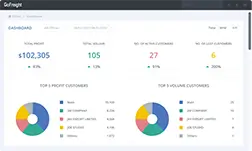In the dynamic landscape of international trade, shipping terms serve as the bedrock of clarity and understanding. Just as a ship anchors in a port, these terms anchor trade relationships in a sea of potential misunderstandings. One such term, paramount in its importance, is “DAP” or “Delivered At Place.” But what is DAP, and why should businesses care? This term, among others, sets the tone for how goods navigate across borders, how costs are divided, and where responsibilities lie. Both the buyer and the seller find themselves woven into the narrative of DAP shipping, shaping their trade engagements. As we navigate the seas of global commerce, understanding terms like DAP can be the difference between smooth sailing and choppy waters.
The Intricacies of DAP Explained
“DAP” stands for Delivered At Place, a term that has anchored many an international trade agreement. But the simplicity of the term belies its profound implications in the world of commerce. To understand its nuances, let’s unpack it further:
Evolution of DAP: Over the years, the push for clear guidelines in trade led to the formulation of such incoterms rules. DAP emerged as a solution for scenarios where the delivery occurs before the goods are cleared for import.
Significance in Commerce: In a DAP shipping agreement, the seller bears the responsibility of all risks and costs until the goods are ready for unloading by the buyer at the named place of destination.
Flexibility and Clarity: DAP provides a balanced middle ground, differentiating itself from terms like DDP (Delivered Duty Paid), where the seller assumes all the costs and risks up to the destination point.
Role in Risk Management: DAP clearly delineates when the risk transfers from the seller to the buyer, ensuring both parties are on the same page.
For businesses venturing into international markets, comprehending the intricacies of DAP is akin to mastering a pivotal chapter in the book of global commerce.
DAP vs. Other Shipping Terms
The world of international trade is vast, and with it comes a myriad of shipping terms that dictate the roles and responsibilities of buyers and sellers. Among these terms, Delivered At Place (DAP) and Delivered Duty Paid (DDP) are perhaps the most frequently juxtaposed, given their closely related contexts. Understanding the distinctions between them is crucial for any business wanting to navigate the waters of global commerce confidently.
DAP (Delivered At Place):
Risk Transfer: In DAP agreements, the risk transfers to the buyer the moment the goods are made available for unloading at the specified destination. This means that the seller covers all transportation costs and risks until that point.
Costs Covered by the Seller: This includes transport, export packaging, and even securing export licenses. However, import duties and customs clearance are typically borne by the buyer.
DDP (Delivered Duty Paid):
Risk Transfer: Under DDP shipping terms, the seller retains the risk until the goods arrive at the buyer’s premises, fully cleared for import.
Costs Covered by the Seller: The seller is responsible for all the costs and risks associated with delivering the goods right up to the buyer’s doorstep. This even includes paying import duties, local taxes, and ensuring proper clearance at customs.
In essence, the main distinction lies in who assumes the responsibilities of import clearance and associated costs. In a DAP scenario, it’s generally the buyer’s responsibility, while under DDP, the seller takes the helm. By discerning the nuances between these terms, businesses can make informed decisions, tailor their shipping terms to their strategic needs, and ensure smoother trade relationships.
Import Duties, Costs, and Responsibilities in DAP Shipping
Navigating the labyrinth of international trade can be challenging, especially when it comes to understanding who is responsible for what in shipping processes. DAP, or Delivered At Place, is one such shipping term that often prompts questions, particularly around the delineation of responsibilities and costs between the seller and the buyer.
Seller’s Responsibilities:
Shipping Goods: The seller ensures that the goods are transported up to the buyer’s designated destination or specified location. This includes bearing the shipping costs and any applicable freight charges.
Risks until Destination: In DAP agreements, the seller bears most risks until the goods are ready for unloading at the place of destination.
Export Formalities: The seller is responsible for fulfilling all the necessary export formalities, including securing export licenses and dealing with export packaging.
Buyer’s Responsibilities:
Import Duties and Taxes: One of the salient features of DAP shipping is that the buyer is responsible for paying import duties, local taxes, and any other applicable tariffs upon the goods’ arrival.
Customs Clearance: Ensuring proper import clearance is the buyer’s duty. This includes navigating customs formalities, securing the necessary documentation, and managing any costs linked to customs clearance.
Unloading Costs: Upon reaching the final destination, the buyer assumes the costs and responsibilities of unloading the shipped goods.
The relationship between DAP shipping costs and benefits is a balancing act. While the seller takes on the initial transportation costs and the risks associated with getting the goods to the agreed-upon location, the buyer needs to manage the complexities of import duties and customs. The clear guidelines established by DAP incoterms help both parties have a clear understanding of their roles, ensuring smoother transactions and fostering trust in international trade. By thoroughly comprehending the ins and outs of DAP shipping terms, businesses can make well-informed decisions that optimize both costs and benefits.
International Trade and the DAP Agreement
The expansive realm of international trade is built on a foundation of trust, transparency, and well-defined guidelines. Among the plethora of international commercial terms that facilitate this global exchange, Delivered At Place (DAP) has emerged as a linchpin, decisively influencing trade dynamics.
DAP’s Role in Shaping Trade Dynamics:
Enhancing Transparency: DAP agreements offer clear guidelines on responsibilities, ensuring both the buyer and seller understand their duties. This clarity fosters trust and minimizes potential disputes.
Facilitating Cost Predictability: With DAP, businesses can anticipate transportation costs and import duties, aiding in accurate budgeting and financial planning.
Optimizing Risk Management: DAP agreements clearly delineate where risk transfers from seller to buyer, making risk management more straightforward for both parties involved.
Flexibility in Delivery: DAP offers flexibility in terms of delivery locations, be it a port close to the buyer, a specific storage facility, or the buyer’s warehouse. This flexibility can lead to more strategic and efficient shipping decisions.
DAP agreements, with their structured guidelines, serve as a foundation for transparent and smooth trade between nations. They not only provide a clear framework that defines responsibilities but also facilitate predictability, making the shipping process more manageable. As international trade continues to grow in complexity, terms like DAP become invaluable in ensuring trade flows seamlessly. By integrating such agreements, nations can foster mutual trust, promote trade relationships, and ensure that international trade remains a driving force for global prosperity.
The Road to Import Clearance in DAP Shipping
Navigating the intricacies of international trade is no simple task. One of the most pivotal stages in this process is import clearance, and understanding its nuances can be the difference between smooth trade operations and logistical nightmares. Here’s a breakdown of the journey of goods in DAP shipping and what every buyer should be aware of when it comes to import clearance.
The Journey of Goods:
Initiation: It all starts at the seller’s premises, where goods are prepared for shipping. This involves ensuring export packaging is in order and acquiring necessary export licenses.
Transit: The goods then commence their journey, potentially crossing oceans via sea freight or being transported overland. The seller is responsible for the transportation costs and ensuring the goods arrive safely at the specified destination.
Arrival: Once the goods reach the agreed upon location or place of destination, the risk transfers to the buyer. This is the point where DAP’s essence comes to the fore – the goods have been delivered at the designated place, but not yet cleared for import.
Intricacies of Import Clearance:
Responsibility: Under DAP, the buyer is responsible for import clearance. This includes managing customs formalities, paying import duties, and handling applicable taxes.
Documentation: Proper clearance requires specific documentation, such as the commercial invoice, that verifies the value and nature of the goods. It’s essential for buyers to be acquainted with documentation requirements for seamless clearance.
Potential Costs: Beyond the anticipated import duties, buyers should be aware of possible local taxes, import tariffs, and any additional costs associated with the shipping process.
For businesses engaged in international trade, understanding the path to import clearance within the framework of DAP shipping is crucial. It provides a roadmap to navigate potential challenges and ensures goods move from seller to buyer with minimal disruption.
The Harmonization of International Trade with DAP
In the vast and intricate world of international trade, Delivered At Place (DAP) stands out as a pivotal term that fosters transparency and smoothness in the shipping process. It elegantly bridges the gap between seller and buyer responsibilities, ensuring that goods traverse borders with clarity on who bears what costs and risks. DAP not only simplifies trade logistics but also strengthens international relationships by setting clear guidelines for the shipping journey. For businesses eager to thrive in the global market, diving deeper into DAP and the complexities of international trade is not just beneficial—it’s essential. By fully grasping DAP and its counterparts, companies can better navigate the seas of international commerce, ensuring successful trade endeavors and fortified global connections.





